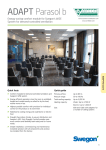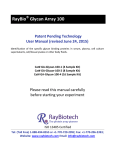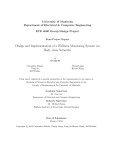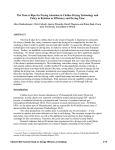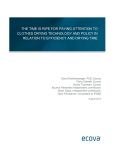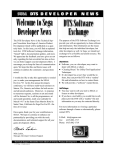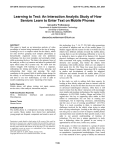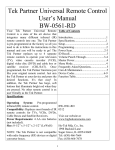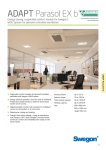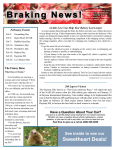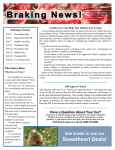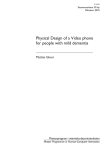Download graphic - SMARTech
Transcript
Microwave Oven Concept Design for OLDER ADULTS Xuejiao LIN Advised by Dr. Claudia B. Rebola ACKNOWLEDGEMENTS I would like express appreciation to my advisor, Dr. Claudia B. Rébola, who guided and supported me throughout the project. Without her help this project would not have gone this far. I would also like to thank Kevin Elrod, who works with Lutheran Towers Midtown Atlanta. His knowledge in terms of senior living gave me a comprehensive background of current retirement community. His persistent and heartwarming help made possible for most of my field study. Last but not the least, I would like to thank my friend, Jige Quan, whose encourage and help made the whole process less painstaking. ABSTRACT Microwave ovens can be used to perform varied cooking and food preparation related tasks with greater efficiency and convenience than traditional cooktops and ovens. Microwave ovens have been highly adopted by older adults in the past 40 years, especially those living in small spaces such as retirement communities. As industry develops microwave ovens with more and advanced functions, it poses a challenging usability factor for older adults in regards to complexity of use. Furthermore, older adult’s abilities may decline with age, adding an additional factor for operating microwaves. The purpose of the project is to not only understand older adult’s current usability factors of microwave ovens, but also develop an improved microwave oven design for older adults. This project will discuss research results including surveys, space assessment, market reviews and usability testing of microwave ovens as well as the process for designing microwave ovens for older adults living in retirement communities. The significance of this project is to design products that are better suited for older adults’ needs in relationship of adoption and usability of everyday technologies. TABLE OF CONTENTS Project Background 2 Phase 1 : See 8 Demographic trends 16 Independent living 24 Story of microwave ovens 32 Current product research 40 Phase 2 : Investigate 46 Interview with residents 54 Design for older adults 74 Phase 3 : Design 86 Concept exploration 90 Concept development 196 Phase 4 : Evaluate 122 References 136 Phase 0 PROJECT BACKGROUND 2 OVERVIEW INTRODUCTION The microwave oven, one of the major modern kitchen appliances, can be used to perform many cooking and food preparation related tasks with greater efficiency and convenience than a traditional cooktop and oven. Today, microwave ovens have been highly adopted by older adults. Some of them have been using microwave ovens for over 40 years. However, the situation is changing. Microwave ovens have been developed with more advanced functions, which adds to their complexity in use. On the other hand, the abilities of users are declining as they get older. Additionally, more and more older adults are choosing retirement community as their home. All these factors combined, new needs have emerged for a rethinking of the design of the microwave oven. The purpose of this project is to design an innovative microwave oven for older adults, as well as have it fit in small living space such as retirement community. An additional purpose is to design more usable appliances for a wider range of the population who live in small apartments. 3 Phase 0 ROLES There are three roles in this project—designer, community, and user. The designer researches related areas and gets information from the user through a series of surveys and data analysis to generate design solutions. The community provides insights regarding senior living and coordinates research activities with residents. The user participates in interviews, observations, and usability tests to communicate with the designer about their concerns and thoughts when using products. 4 OVERVIEW Designer Community User Roles in this project 5 Phase 0 SIDE FRAMEWORK The process consisted of four phases—see, investigate, design, and evaluate (SIDE). The “See” phase provides a comprehensive background for this project by uncovering data about the history of microwave ovens, population trends, and the state of older adults, independent living, and retirement communities. The “Investigate“ phase develops inspiration using qualitative research and market research methods to generate innovative design solutions for the current problem. The “Design” phase generates design concepts to address user needs and expectations. After several iterations, a final design concept will be selected to proceed to appearance modeling and testing. Lastly, the “Evaluate” phase validates design decisions and evaluates the final design through a series of usability tests to make possible changes and improvements afterwards. 6 OVERVIEW See Investigate Design Evaluate “SIDE“ framework 7 Phase 1 8 SEE S SEE 9 Phase 1 10 SEE 11 KITCHEN IN RETIREMENT COMMUNITY Phase 1 12 SEE 13 COMPUTER ROOM IN RETIREMENT COMMUNITY Phase 1 14 SEE GOAL OF PHASE 1: The goal of this phase is to provide a comprehensive background for this project by uncovering data on the history of microwave ovens, population trends, the state of older adults, independent living, and retirement communities. 15 Phase 1 DEMOGRAPHIC TRENDS 16 SEE “” In 2011, the oldest baby boomers— Americans born between 1946 and 1964—will start to turn 65. Today, 40 million people in the United States are ages 65 and older, but this number is projected to more than double to 89 million by 2050. - America’s Aging Population, 2011 17 Phase 1 ELDERLY POPULATION GROWTH The world population passed the 7 billion mark in 2011. In mid2012, it grew to 7.06 billion. Developing countries accounted for 97% of this growth. However, in developed countries, the annual number of births barely exceeds deaths. Reports predict that in 2050, the population increase of those 65 and over will be 2.5 times that of the population under 4 due to a low birth rate in developed countries coupled with birth rate declines in most developing counties, which is an exact reversal of the situation in 1950. By 2050, the number of people aged 65 and over will total 1.5 billion or about 16% of the global total. But in 1950, it was only 5%. (Population Reference Bureau, 2012) AGE 65 AND OVER 2010: 0.5 B 2050: 1.5 B World Percentage of People ages 65 and over 18 SEE 9,700,000,000 Population Increases to 9.7 Billion 2011 Population Increased population by 2050 19 Phase 1 ELDERLY SUPPORT RATIO The coming surge in the number of people over 65 raises a big concern—whether those older people will get enough support and care for their life. One way to measure this is using the Elderly Support Ratio (ESR). ESR is the number of working-age adults 18-64 compared to that of elderly persons aged 65 and over. In 1900, the ratio was 14:1, while by 1960, this ratio declined to 6:1. Today, the ESR in the US is about 5. But this ratio will continuously decline to less than 3 by 2050. 5.5 or more persons 4.5 to 5.4 persons 3.5 persons to 4.4 persons Fewer than 3.5 persons Elderly Support Ratio by County, 2009 20 SEE Many older adults rely on family caregivers for support and assistance. However, changes in family patterns may reduce the availability of family caregivers. In the US, nearly half of women born during the baby boom will divorce by age 65. The situation for men is similar. This means that more people will reach 65 without having a spouse to rely on for care as they age. In addition to high levels of divorce, later marriage and nonmarital births in young adults make this situation worse. There has been an increase in both single-parent families and “blended families” in the US. It is hard to say whether children will be willing to care for their “multiple parents” when they are elderly. Diagrams from America’s Aging Population by Population Reference Bureau Less than 13% 13% to 15% 16% to 19% 20%+ Percent of Population Ages 65 and Over by County, 2009 21 Phase 1 A higher number of people aged 65 and over, lower birth rate in developed and developing countries, high divorce rate, and growing complexity in family structure all reveal a pressing problem in the near future—caring for elderly people. Although most older adults would prefer to age at home as long as possible, care given as a family unit will be harder in the next couple of years. Without effective mental and physical care, it could be dangerous and unhealthy for older adults to live by themselves. Therefore alternative solutions need to be considered to address the problem. One solution is to have an outside caregiver to support older adults living at their homes. However this could be expensive and inefficient since most older adults still retain the ability to live independently. Another solution, which is more suitable for the situation, is independent living. 22 D G T D DEMO GRAP TREN DEMO SEE 23 Phase 1 INDEPENDENT LIVING 24 SEE “” As you get older; you’ve probably noticed that you tend to forget things. You’ll be talking with somebody at a party, and you’ll know that you know this person, but no matter how hard you try, you can’t remember his or her name. This can be very embarrassing, especially if he or she turns out to be your spouse. - Dave Barry 25 Phase 1 AGING IN PLACE Aging in place is “the ability to live in one’s own home and community safely, independently, and comfortably, regardless of age, income, or ability level.” The focus of aging in place is to help older adults ensure they can live where they choose and get any help they need for as long as they can. (Cresci, 2005) As people age, bodies and capabilities change. This could include: • Reduced vision • Decreased muscle strength or endurance • Reduced mental processing capabilities • Increased risk of falls due to balance • Increased risk of illness • Reduced hearing • Decreased mobility Arthritis 26 SEE These changes happen to most older adults, which can affect many activities of daily living, such as getting around their home as easily, driving safely, transportation, socializing, home upkeep, and health maintenance. (Seidel et al., 2010) Research shows that a loss of function in activities of daily living is less likely to be recovered by older adults. So the longer they can keep up with the activities of daily living, the less support they would need for living independently. There are ways to help them live independently. INCREASING MOBILITY. Assistive technology and devices, such as walkers, scooters, and household modifications, such as grab bars, bath seats, or ramps, give older adults necessary support for get around their home. SUPPORTING CAREGIVERS. Trained caregivers can help improve the quality of life for older adults. For example, a caregiver can be trained for managing illness related skills, cognitive strategies, etc. IMPROVING MENTAL FUNCTION. Research shows that mental exercises can improve cognitive abilities. These training could be memory, concentration, and problem-solving skills to improve speed of processing and reasoning. CONNECTING WITH OTHERS. Socializing and communicating with others helps older adults reduce depression and realize self-value as well as keep the mind in a healthy and active state. First appearing in the 1950s, retirement communities embrace most of the features that enable older adults to live independently, and have increasingly become a choice for older adults aging in place. (Wikipedia, 2014) 27 Phase 1 RETIREMENT COMMUNITIES Retirement communities, sometimes also called independent living communities, are housing specifically marketed to people ages 55 and over. There are approximately 640,000 residents living in over 2,000 retirement communities around the US. Retirement communities are becoming more and more popular, as the number of older adults in such retirement communities has more than doubled in the past 10 years. These retirement communities enable older adults to live independently in a safer and more active environment. With 24-hour staff responding to emergencies and housekeeping services, older adults can live in their own apartments but still receive help when needed. Residents can maintain an individual independent lifestyle, but if they want to look for more, there are always amenities and activities offered by the community. Retirement communities are usually managed by a private firm which provides hospitality services such as dining, housekeeping, wellness programs, and cultural activities. Some even have other facilities such as restaurants and salons. 28 SEE 29 SILVER MAPLES RETIREMENT COMMUNITY IN CHELSEA MICHIGAN Phase 1 A retirement community home is much like an apartment or condo. They come in a variety of floor plans: studio, one bedroom or two bedroom or larger. Most retirement community homes provide major appliances in the kitchen, such as a refrigerator, range, and garbage disposal. The bathrooms usually have safety features such as grab bars and emergency call systems. In addition, all apartment maintenance is taken care of by the management crew. These apartments are relatively smaller than normal residential apartments. One advantage of a smaller floor plan is to reduce effort for older adults in getting around the apartment which reduces the risk of falling. However, this also results in a smaller kitchen area. COOKING WITH MICROWAVE OVENS Meal preparation is crucial to independent living. (White & Devitt, 2011). Comparing to traditional cooking tools, such as cooktop, microwave ovens provide convenience and efficiency of cooking. As people age, they may have difficulty with mobility as well as declining body capabilities, which increases the effort to perform regular cooking related tasks (Slegers, van Boxtel, & Jolles, 2009). Therefore, the microwave oven has an increasing popularity among older adults. (Nagarajan, Lovingood, Beamish, & Parrott, 1999). Microwave ovens can perform many tasks of cooktop and traditional ovens, with the right power level and time. In addition, a microwave oven needs less space, which could be a better solution for cooking in retirement community. 30 I L I L INDE LIVIN INDE LIVIN SEE 31 Phase 1 STORY OF MICROWAVE OVENS 32 SEE “” There is no important reason why the housewife of the future should not purchase completely frozen meals at the grocery store just as she buys quick frozen vegetables. With a quick heating, highfrequency unit in her kitchen, food preparation from a pre-cooked, frozen meal becomes a simple matter. - C. Guy Suits, 1947 33 Phase 1 HISTORY Microwave ovens have appeared in many people’s kitchens since the 1990s. But the very first one was invented in 1947. In 1946, an incident made the discovery of the power of microwave when Percy Spencer, the American engineer, was working on a live radar set and found a melted chocolate bar in his pocket. However, domestic counter-top microwave ovens were not made available for consumers until 1967. They were sold by a company called Amana and priced at $495. Finally Litton made the short, wide shape of microwave ovens that we see today. Ever since then, with the evolution of technology, microwave ovens have made their way to many people’s kitchens. By 1997, 9 out of 10 American households had a microwave oven, as reported by U.S. Bureau of Labor Statistics. Today, most microwave ovens are the same type of shape—wide and short, but differentiate in many sizes, colors, capacities, power outputs, installation types, etc. (Wikipedia, 2014) 34 Dr. Percy Spencer finds the chocolate bar in his pocket and realizes that microwaves cook food fast. The first commercial microwave oven were 5 1/2 tall, and 700+ pounds, had to be connected to plumbing. The first microwave oven for home-use were in a cabinet the size of a refrigerator, priced at $1295. 1946 1947 1955 Sold by Amana, this model used less energy, and much smaller and safer, only cost $495. 1967 SEE The timeline of microwave oven history Standards set by FDA put in place, fixed previous problems with microwaves leaking, 1971 In the 70s, microwave ovens became more and more inexpensive, and plumbing was no longer needed thanks to air cooled system. By 1975, microwave ovens were sold more than gas ranges. 1975 Today, more than 95% of households have a microwave oven. 2011 35 Phase 1 DIVERSITY There are three major types of microwave ovens in the market. Most still sit on the countertop (OTC), but more people are mounting microwave ovens over the range (OTR), which saves counter space to some extent. Another type is built-in (BI). This type of microwave oven is mounted within customized cabinets, either in island or wall units or over counters. Some OTCs can be installed under a cabinet or used as a BI and installed with custom cabinets. While OTRs can be vented to the outside, they are less powerful than a range hood. Finally the BIs usually do not have finished sides, not do they have vents. COUNTERTOP BUILT-IN Types of microwave ovens 36 OVER-THE-RANGE SEE 37 A COUNTER TOP MICROWAVE OVEN IN A KITCHEN Phase 1 Apart from different body types, microwave ovens have become faster and smarter. Many have sensors that automate cooking for different kinds of food. Some even include convection and slow cooking functions to increase cooking capability. However, along with these awesome functions, the interface of microwave ovens has become more and more complicated. From a single dial knob to multiple buttons, some functions are hard to perform even with a user manual in hand. There might be more trouble for older adults—learning and cognitive abilities are decreasing as people age; the complexity of microwave ovens works as a counter-factor to its ease of use. Complicated Interface 38 S O M O STOR OF MICR OVEN SEE 39 Phase 1 CURRENT PRODUCT RESEARCH 40 SEE “” Searching is half the fun: life is much more manageable when thought of as a scavenger hunt as opposed to a surprise party. - Jimmy Buffett 41 Phase 1 VOLUME vs. PRICE vs. BODY TYPE As a big factor to kitchen space arrangement, the volume of a microwave oven is important to users. Below is the price vs. volume distribution of current microwave ovens sold in the market. volume price Chart of price and volume distribution 42 volume SEE Counter-top is usually cheaper than the other two types, but also smaller. The lowest price for counter-top is around $60, at 0.7 cu.ft. While the lowest price for over-the-range is around $150, at 1.6 cu.ft. COUNTER-TOP OVER-THE-RANGE BUILT-IN volume price volume 43 Phase 1 EXISTING FEATURES There are many models in the market. They are differentiated in installation type, size, power, and preprogrammed functions. The three main types, countertop, over-the-range and built-in, all have pros and cons. (ConsumerReports, 2014) Table of type comparison PROS COUNTER-TOP OVER-THERANGE BUILT-IN 44 CONS Cost less No installation needed No electrician needed Midsized and large models need about 3 quare feet counter space. No occupation of counter space Cost more Need installation Not vent too well No occupation of counter space Allow to have a hood Usually cost most Need installation Need custom cabinet SEE POWER RATING. Most microwave ovens are rated between 600– 1,200 watts. Typically this is correlated to the size. Compact ones are about 600–800 watts, while midsize and large ones could be at 850–1,200 watts. More watts usually means more cooking power. NUMERIC KEYPAD VS. DIAL. Today, more and more microwave ovens have a numeric keypad for setting cooking times and power levels. But there are still ones using a dial knob. TURNTABLE VS. TRAY. Most microwave ovens have a turntable that rotates the food to keep food heating uniformly. There are microwave ovens using a rectangular tray that slides from side to side to perform the same functionality. SENSOR COOKING. A sensor measures emitted steam to determine when food is done. This helps prevent under or over cooking. SHORTCUT KEYS. There are auto settings for certain kinds of food, such as popcorn, vegetable, baked potato, and pizza, as well as for certain functions such as reheating and defrosting. By pressing the appropriate button, there is no need to worry about cooking time and power level. ADD 30 SECONDS KEY. This extends the preset cooking time by pressing once or multiple times. Some have an add 1 minute key. 45 Phase 2 46 INVESTIGATE I INVESTIGATE 47 Phase 2 48 INVESTIGATE 49 A MICROWAVE OVEN IN KITCHEN OF RETIREMENT COMMUNITY Phase 2 50 INVESTIGATE 51 INTERVIEW WITH RESIDENT Phase 2 52 INVESTIGATE GOAL OF PHASE 2: The goal of this phase is to get inspiration using qualitative research methods and to generate innovative design solutions to the current problem. Qualitative research helps develop deep empathy for people that are being designed for, understanding their issues, needs, and expectations through questions and observation. 53 Phase 2 INTERVIEW WITH RESIDENTS 54 INVESTIGATE “” I don’t build a house without predicting the end of the present social order. Every building is a missionary... It’s their duty to understand, to appreciate, and conform insofar as possible to the idea of the house. - Frank Lloyd Wright, 1938 55 Phase 2 INTERVIEWS Recruited from a local retirement community, a total of six participants were interviewed, including three males, two females, and a couple. The gender, ethnicity, marital status, and health state were well distributed. They all live independent of nursing or caring. One of them didn’t have a microwave oven; one was a wheelchair user; one had low vision. All interviews were semi-structured. Interviews started with simple introductory questions, such as “how often do you cook?” and “how do you like cooking?” The interview then went deeper with questions specifically related to microwave ovens, such as “how often do you use microwave ovens?” and “what do you use them for?” During this process, after a certain question was asked, participants would sometime talk more about their experience. If this happened, follow-up questions would be asked to prompt them to go deeper on that topic. 56 INVESTIGATE WORD CLOUD The word cloud method was used to catch important words that participants mentioned during interviews. The size of words was correlated to the frequency of the word appearing in the conversation. Wordcloud summarized from interview transcript 57 A MICROWAVE OVEN IN KITCHEN OF RETIREMENT COMMUNITY Phase 2 PARTICIPANT #1 Participant #1 lives in a studio apartment with his cat. He has been living in this retirement community for almost 6 months. He has minor hearing issue. refrigerator cooktop toaster Kitchen layout 58 INVESTIGATE HIGHLIGHTS Question Answer How often do you eat at home? Well since I moved in here, I eat just about all my meals here. Do you enjoy cooking? Be honest I don’t like to cook. And when I moved in here, I realized how much I don’t like it. How many meals do you cook everyday? I am lucky if I cook two, but I do have leftovers. I also have a lot of frozen food. Most of them done in the oven. 59 Phase 2 PARTICIPANT #2 Participant #2 lives in a one-bedroom apartment. She has minor hearing issue. She is the only one who has a dial-knob-microwave oven. microwave oven refrigerator cooktop toaster Kitchen layout 60 INVESTIGATE HIGHLIGHTS Question Answer How many meals do you have everyday? Twice, breakfast and lunch. Do you eat at home? Just a little bit. The other one helps me here. Sometimes she cooks for me. Do you often cook with fresh ingredient or frozen/prepackaged food? I like frozen food. I also eat some vegetables and fruits. I have trouble with digesting meat. Do you have a microwave oven? Yes, right there. How often do you use microwave oven to cook? I don’t like cooking with it, I put soup in it... heat. I like hot food. And frozen food I put them in the microwave too. How many minutes do you usually set for time cooking? 2-3 minutes, sometimes 5 minutes. Have you tried to cook meal with it? No, I have never tried to cook. I don’t know what that could use it or not. 61 Phase 2 PARTICIPANT #3 Participant #3 lives in a one-bedroom apartment. He has mild arthritis, cannot hold things for long time. He likes to stay at his apartment, spending time on books, TV and computer. He has a lot of friends around the world, sometimes he writes email to them. microwave oven refrigerator cooktop toaster Kitchen layout 62 INVESTIGATE HIGHLIGHTS Question Answer How many meals do you have everyday? Two, breakfast perhaps... For lunch I have meals delivered either from hospital next door or order things in from restaurants. I use microwave in the morning or afternoon. What do you use microwave oven for? I use more to heat things than to cook. I do steam vegetables, but I don’t cook much of anything in it. But I wouldn’t want to do without one (microwave),They are excellent for warming things. What are the things do you usually warm in the microwave oven? I warm up soups, canned soups, I pour it over the mug and put in the microwave, then boom, in 60 seconds it’s hot and ready. Have you encounter any problem with using microwave oven? Years ago, probably two or three microwaves ago, I decided that I was going to scramble an egg in the microwave. That was a mistake. Do you think microwave improves anything? It’s a matter of time. It takes 60 seconds to heat up a can of soup in the microwave. If I put it in the sauce pan, I have then to wash the sauce pan, and it doesn’t heat any more quicker, takes about 3 or 4 minutes on top of the stove, and I get another vessel or utensil to keep clean. I don’t have somebody to help me everyday. 63 Phase 2 PARTICIPANT #4 Participant #4 is a couple living in a one-bedroom apartment. They moved to the apartment six months ago. They have a microwave oven, but it was sitting in a shelf in the living room. The wife has minor hearing issue, and the husband has mobility issue. microwave oven refrigerator cooktop Kitchen layout 64 INVESTIGATE HIGHLIGHTS Question Answer How do you enjoy cooking? - I used to really enjoy cooking. But after my kids left home, and we’ve gotten older, I would really like to fix something quick and easy. - We eat a lot of frozen things. But as far as microwave cooking I would like to know how to do simple things quickly. It just two of us, so I don’t want to spend a lot of time cooking. What appliances do you use for cooking? We use the oven, the eyes on the stove, and the microwave. When you use the microwave oven, what function do you mostly use? - We don’t cook whole meals in the microwave. We warm prepackage or leftovers. - Once again I would like to be able to fix something nutritious, quick and easy, like a casserole... Have you encountered any issue with using the microwave oven? - There is a problem - we don’t use various powers. You can use multiple powers like 50%. but I don’t know how to do that. - Before we came here, we had a microwave that built in over the stove. It was more powerful than this one. We can cook a lot of things in it. 65 Phase 2 PARTICIPANT #5 Participant #5 lives in a one-bedroom apartment. He was artist, he used to do sculptures and paintings. He moved here since two years ago. He has been trying to live healthier after he got diabetes. microwave oven refrigerator cooktop Kitchen layout 66 INVESTIGATE HIGHLIGHTS Question Answer How many meals do you have everyday? I am a diabetes, so I have to eat breakfast, lunch and dinner. Every other day I will check my blood sugar and blood pressure. ... So you cook all the meals? I cook all my meals. When I was a artist, I was also a cook. I know how to cook. Do you enjoy cooking? Oh yeah, and sometimes I would invite people to come eat with me. When would you use the microwave oven? I would use it to defrost burger for 45 seconds. Or warm up a cup of coffee. Could you describe how do you defrost the burger? I hit the number pad for 45 seconds. It would be nice to have increments on the microwave, like 15s, 30s, and 45s... I think it would be a kind of cool if you could design one that go on a corner. ... So you don’t use the actual function button, like there’s is defrost button, do you use that? I hardly use that. I seemed like to hit that button and it messed up with other buttons. I seemed hitech but I’m really not... *laugh* Other improvements can you think of to improve the microwave oven? It would be helpful if it had a red dot on start button or it’s color coding somehow, so if you visually impaired you can actually see what to do. 67 Phase 2 PARTICIPANT #6 Participant #6 lives in a one-bedroom apartment. She is a wheelchair user. She has 13 children. She is attending a online course. Her kids visit her sometimes and bought her a lot of things. Her microwave is located in the living room rather in the kitchen because there’s not enough room in the kitchen and it’s easier for her to access on a wheelchair in the living room. microwave oven refrigerator cooktop Kitchen layout 68 INVESTIGATE HIGHLIGHTS Question Answer How often do you eat at home? I eat at home all the time. How do you enjoy cooking? I love to cook. I have 13 children I still want to cook. And I hate to waste food. So I’ll freeze the leftovers and when I go back I can put it in the microwave and warm it up. Do you often cook with fresh ingredient or frozen/prepackaged food? I went to hospital in July, so I had to have fresh vegetables and stuff. I can’t have much sodium in my food because my blood pressure went up high. Sometimes I buy packaged food like frozen dinners, ones said low sodium. I also get meals on wheels. And I warm that up in there in the microwave. What are the reasons for you to use the microwave oven? I’d say for the speed, the time. You can do so many things instantly. If I want something really fast, I will go to microwave. How many minutes do you usually set? 2-3 minutes... But if I make baked potatoes, I’ll use 100 minutes, bigger one for 15 mins and it’s well done. 69 Phase 2 FEATURE COMPARISON During the interviews, the details of the microwave ovens that the participants currently used were compared. The following is a table of comparison among some key features including price. POWER RATE PARTICIPANT #2 600W KEYPAD vs. DIAL Dial (Only for time setting) 70 PARTICIPANT #3 1200W Keypad PARTICIPANT #4 900W Keypad PARTICIPANT #5 800W Keypad PARTICIPANT #6 1200W Keypad INVESTIGATE Table of feature comparision PRICE SENSOR COOKING SHORTCUT KEYS $50 No No $169 Yes 7 $50 No 6 $20 No 3 Yes 4 (Used) $226 71 Phase 2 CONCLUSION 1 Users need a more space saving microwave oven! Participants #2–5 use counter-top microwave ovens. Clearly this body type fits such apartments and is more economic. Many current models don’t fit in such a small kitchen space in retirement communities. The counter space is so limited and filled with all kinds of tools, utensils, and supplies. Participant #5 expressed the desire to have a microwave oven to fit in the corner so he could save more room on the counter for other use and storage. Participants #4 and #6 had to move their microwave ovens to the living room. 72 INVESTIGATE CONCLUSION 2 Users get confused when using microwave ovens! They are very happy with the efficiency of the microwave oven, which can heat up their leftovers or pre-packaged food in seconds or minutes. However, they are not familiar with most of the pre-set functions and only use very limited functions, such as time cooking. The purposes of using a microwave oven are mainly for warming/heating and defrosting. Some might use it to bake potatoes or steam vegetables. Presets are typically made for certain kinds of food, which are usually limited to about 6–8 kinds. However, the participants expressed that they rarely use those presets. Furthermore, these presets may also be potential safety issues. Participant #5 brought up that he once hit a button he had no idea what it was, then the microwave oven was broken. Furthermore, more buttons means a higher chance of malfunction, such as one of the number buttons doesn’t work. 73 Phase 2 DESIGN FOR OLDER ADULTS 74 INVESTIGATE “” Novelty has charms that our minds can hardly withstand. - William Makepeace Thackeray 75 Phase 2 UNIVERSAL DESIGN PRINCIPLES The aim of the universal design principles is to produce products and environments that are inherently accessible to older adults and people with or without disabilities. Curb cuts, sidewalk ramps, and door handles (instead of door knobs) are examples of universal design. A universal design should follow the following principles: • Equitable use • Flexible in use • Simple and intuitive • Perceptible information • Tolerance for error • Low physical effort • Size and space for approach and use These principles can be helpful to some extent when it comes to the idea of design for all, yet older adults often are not people with disabilities, they are only people with declined abilities. 76 INVESTIGATE DESIGNING FOR OLDER ADULTS Keeping universal design principles in mind when design for older adults, we have to understand their special characteristics. Older adults are different than younger generations in many aspects. In the book of Designing for Older Adults, the characteristics are divided into three categories—sensation and perception, cognition, and movement control. Sensation and Perception. Taste, smell, touch, vision, and auditory all show declines when people age. Changes in haptics increase the chances of falling. While changes in vision also cause slower adaptation to dark, visual processing speed, decreasing breadth of visual field and perceptual flexibility. Cognition. Memory and attention decline in some aspects. Memory shows declines in holding/manipulating information, slower access to information, less chance in remembering what to do in the future, and how to do something. Declines in attention cause slower speed in searching things and lower performance in coordinating multiple tasks. Movement Control. Older adults need more time to respond than younger adults, and are usually less accurate and precise. The essential goal of designing a product is to make it useful to people. There are five attributes when it comes to measuring the usability of a product—learnability, efficiency, memorability, errors, and satisfaction. Therefore, a more useful product needs to be more easily learnable and memorable, and not conducive to errors. (Fisk, Rogers, Charness, Czaja, & Sharit, 2004) 77 A MICROWAVE OVEN IN KITCHEN OF RETIREMENT COMMUNITY Phase 2 SYMPATHETIC DESIGN Sympathetic design is a framework that helps designers to design technology for older adults. It combines and develops the approaches from evidence-based design and usercentered design. (Claudia & Brian, 2013) The framework provides guidance in five areas—product functionality, product interface, design research methods, universal design, product experience, and technology use. SYMPATHETIC DEVICES DESIGNING TECHNOLOGIES FOR OLDER ADULTS PRODUCT FUNCTIONALITY Simplicity Basic Needs PRODUCT INTERFACE Tangible Contextual DESIGN RESEARCH METHODS Participatory Design Contextual Design PRODUCT EXPERIENCE Enjoyment Creativity TECHNOLOGY USE Current Off-shelf Table of sympathetic devices 78 INVESTIGATE SUMMARY To conclude, designing for older adults needs special attention to their levels of abilities, as well as discovering their expectations and needs by involving them in the design process. Combined with the analysis from previous research, the following attributes are summarized to help gauge the future design phase. Ease of Use. It should be easy to learn and remember and have a low risk for making errors. In addition, it should provide multiple ways for accomplishing a certain task to increase its usability. Simplicity of Product. Keep the product simple in appearance but functional to meet the needs. This also applies to the steps that are needed to complete a certain task. Satisfaction of Product. Although older adults may have special needs, they are pretty standard when it comes to aesthetics. Enjoyment and creativity can affects the satisfaction of a product to some extent. Besides, quality and cost should also be taken into consideration. 79 A MICROWAVE OVEN IN KITCHEN OF RETIREMENT COMMUNITY Phase 2 EXAMPLES OF DESIGN There are examples of product designs for older adults. Medminder Medminder is an automatic pill dispenser. It has many types of reminders, such as blinking, beeping, and phone calls. In addition, it has a safety lock which locks all compartments and only leaves the specified compartment unlocked to prevent taking the wrong medication at the wrong time. In addition, it has a built-in cellular connection, therefore it can make phone calls, sent text messages or emails to the caregiver if the patient missed the medicine after a certain amount of time. (MedMinder, 2014) Medminder pill dispenser 80 INVESTIGATE Grandcare Grandcare is a touch platform to help older adults live in their own homes safely. It has four main functions: Activity monitoring—using sensors to report daily activities to Grandcare, caregivers and family member can access the record by logging into the online portal, or even receive phone calls/ text/ emails under certain circumstances. Digital home health—Grandcare can record and store data from other wireless health devices such as a weight and blood pressure. Medication management—Reminds user to take medications by showing the picture of medicine with instructions on the screen. Multi-media socialization—user can use Grandcare to view photos, watch videos, listen to music, and chat with family. (Grandcare Systems, 2014) Grandcare system 81 A MICROWAVE OVEN IN KITCHEN OF RETIREMENT COMMUNITY Phase 2 Tek Partner This remote is designed for older adults. It has extra-large buttons with big text on them. It has a backlit feature which enables older adults to see the text when it is dark. It can control TV, cable, satellite, DVD, and VCR. Users can easily change between different mode with the large buttons. It has a curved design on the back so it can sit on the arm of a chair or sofa safely. Besides, the narrowed center is designed ergonomically for holding and handling. The size is big enough, so it hardly can be lost among furniture. (Bay Products, 2014) Tek partner remote 82 D F O A DESIG FOR OLDE ADUL INVESTIGATE EXAMPLE ANALYSIS Medminder is a good example of providing multiple types of reminder to help older adults remember to take medication. By using this method, the device reduces the chance of human error which in turn increases its usefulness. Grandcare is a good example of converting complex modern technology to simple and intuitive interface and interaction. All options are presented on one screen with simple navigation to the previous/ next page. It works similar to a personal computer with less capabilities, but it provides enhanced controllability for older adults to maintain the status of themselves and the environment around them as well as to communicate with other people. Tek Partner is a good example of enhanced perceptibility. It is easy to read and grab. Functions are differentiated by button shapes. To conclude, the major takeaways from these examples are: • Provide visual clues to guide users in order to enhance the usefulness of the product. • Convert and simplify complex technology, provide functionality based on needs. • Implement features that help older adults better manipulate the product. 83 Phase 3 DESIGN CRITERIA Based on previous research and analysis, design criteria can be defined as following: FORM Small volume, appropriate shape. Limited counter-top space in the kitchen of retirement community makes volume extremely important to its usage. Appropriate shape. Make microwave oven fit in the environment, such as corners. APPEARANCE Simplicity. The look and feel of the product should be concise and clean to reduce unnecessary confusion. Enjoyment. Make microwave oven fun to use, in turn to increase the interest in cooking. Perceptibility. Easy to read, easy to understand. Less hiding functions or information. INTERACTION Ease of use. Modifying interface layout and changing the way of interaction may improve the ease of use.. Learnability and memorability. The product should be intuitive and self-explanatory without effort for learning or remembering. 84 D F O A DESI FOR OLDE ADUL DESIGN 85 Phase 3 86 DESIGN D DESIGN 87 Phase 3 88 DESIGN GOAL OF PHASE 3: The goal of this phase is to generate design concepts to address user needs and expectations. Through iteration, a final design concept will be selected to proceed to appearance modeling and testing. 89 Phase 2 CONCEPT EXPLORATION 90 INVESTIGATE “” Recognizing the need is the primary condition for design. - Charles Eames 91 Phase 3 SPACE USAGE ANALYSIS During the interviews, observations were also conducted. Microwave ovens were placed in different spots for two reasons: low accessibility and space limitation. In order to address these issues in the following phase, a space usage analysis was conducted. Starting from the current situation, users tried to solve these issues by, 1) tilting the microwave oven to a certain angle so user could press buttons vertically, 2) moving the microwave oven out of kitchen and placing it on a shelf for more space in the kitchen. However, these are alternative ways to solve the problem and are not effective; sometimes they may cause more problems for space usage. To find an effective way, changing the microwave oven itself could be a better solution to the problem. Two factors effecting space usage for microwave ovens are 1) the space taken by the body of microwave oven, 2) the space not taken by microwave oven but is not available for other use because of the microwave oven. The first factor means the solid space that is taken by the microwave oven. This space is inevitable. To reduce such space usage, shrinking the size of microwave oven is needed. The second factor can be divided into two circumstances— permanent and temporary occupied space. Permanent occupied space means the fixed area is occupied by microwave oven that cannot be used for other purposes, such as the corner of counter top behind the microwave oven. Temporary occupied space means the area that is available for other purposes but unavailable when the microwave oven is in use, such as opening microwave oven’s door resulting in a fanshape area in front of it that needs be empty (as shown in the graphic on next page). 92 DESIGN microwave oven refrigerator cooktop Layouts of kitchens and major appliances arrangement 93 Phase 3 Therefore, three methods could be considered to reduce the space usage by microwave oven - reduce the size of microwave oven, eliminate permanent and temporary occupied space by microwave oven, in turn to save room for other uses. Permanent occupied space Temporary occupied space 94 DESIGN INTERNAL SPACE ANALYSIS Below is a horizontal intersection of a microwave oven. It is clear to see that space is wasted on the corners of a microwave oven—a rectangle shape with a round turntable inside. So if the corners were not there, for example if the microwave oven were in a rounded shape, the volume could be smaller to some extent. Secondly, space is also wasted on the location of the interface and it components. As for the countertop, the width is much more important than the height. Therefore sided location for interface is not the best choice for space saving. Cross section view of a microwave oven 95 Phase 2 CONCEPT DEVELOPMENT 96 INVESTIGATE “” Simplicity is the ultimate sophistication. - Leonardo da Vinci 97 Phase 3 MOOD BOARD Based on design criteria concluded in the previous chapter, elements were selected to define the overall design style and design language as well as the look and feel of the body material. 98 DESIGN 99 Mood board Phase 3 FORM EXPLORATION Starting from the current form of microwave oven, some basic forms were drawn out to explore what would fit for the design criteria. Furthermore, the possible locations for interface were also explored. In this initial brainstorming, the following forms were explored: circle, half-circle, fan-shape, and hexagon. After comparison, the fan-shape was eliminated since it was too specific for fitting into a corner and was less useful in a situation when no corners involved. The hexagon also was eliminated, since it was similar to the half-circle but with more constraints on arrangement. 100 DESIGN Sketch of initial concepts 101 Phase 3 FORM EXPLORATION The circle shape was further explored. There were two different considerations for the location of the interface—on top and on the side surface. Furthermore, a new organic form was considered. It accommodates a turntable to some extent but the overall form does not match the design criteria established in the previous phase. Thus this concept was eliminated. In addition, the way in which the door operates was considered. It is possible for a circle shape to have a sliding door which could be very beneficial for space saving. Another thought was to change the direction the door opens, from leftto-right hinge door to bottom-to-top. By doing this, the door has less interference with other objects on the countertop. However it may block the sight of the user. Therefore this consideration was eliminated. 102 DESIGN Sketch of initial concepts 103 Phase 3 FORM EXPLORATION Further exploration was made on the half-circle shape. One concept was to add a light strap on the microwave oven as reminder to user when the food is ready. Further consideration was for a timer to show how much cook time remains. However, this is not relevant to the design criteria and poses potential confusion for older adults, thus was eliminated. But the light strap concept can be used for providing clues which can be useful for the user of the microwave oven. 104 DESIGN Sketch of initial concepts 105 Phase 3 FORM ASSESSMENT Space utilization was analyzed for different possible body shapes. SQUARE The square shape reduces a lot of internal space waste horizontally, but potentially adds to the overall height because of relocation of the interface. Alternative orientations for door opening could be considered. However, no matter what orientation is chosen, it is inevitable to have extra space consumption when operating. SQUARE+CIRCLE The square+circle shape reduces more internal space waste than the pure square shape on the back. And it fits into a corner better because of the rounded back. However, the interface needs to be relocated from the side to top or bottom of microwave oven. Again this adds overall height due to interface relocation. CIRCLE The circle shape saves the most space since it basically is a concentric circle to the turntable. The door can operate as a sliding door to slide in and out along the side instead of the traditional hinge door. The downside of the shape is that it is hard to keep the interface on a flat surface which would affect the overall perceptibility of the interface. CIRCLE+ELLIPSE The circle+ellipse shape has the same features as the circle shape, but better addresses the interface issue. However it increases overall volume more than the pure circle shape. 106 DESIGN turntable microwave oven body Current form Square Square+Circle Circle Circle+Ellipse Cross section views of microwave oven concepts 107 Phase 3 FORM COMPARISON A table was established for the purpose of attribute comparison, in order to generate more intuitive information for form selection. Each attribute was converted to scores to better reflect the advantages and disadvantages between each form, for easy calculating overall fitting for this particular project. 108 CURRENT SQUARE P+T SPACE ANALYSIS 1 2 SPACE UTILIZATION (INTERNAL) 1 2 INTERFACE PERCEPTIBILITY 3 3 HEIGHT 2 1 OVERALL 7 8 DESIGN For interface perceptibility comparison, only the location and its surface were taken into consideration, ruling out other factors such as interface design. Height as a simple affecting factor was not analyzed in the previous research but definitely is a factor for space analysis, should be taken into consideration at this time for overall fitting calculation. Table of attributes comparison SQUARE+CIRCLE CIRCLE CIRCLE+ELLIPSE 3 5 4 3 4 3 2 1 2 1 1 1 9 11 10 109 Phase 3 INITIAL CONCEPT Circle was chosen for its overall form. This initial concept has a protruded corner for a flat surface for the control panel. This design decision not only solves the problem of adding extra height on top because of interface relocation, but also keeps all the buttons in the same surface for higher perceptibility. Color exploration 110 DESIGN Interface iterations The button count is reduced to six in order to perform two basic functions—time adjustment and power adjustment. One of the iterations was to add and reduce cook time by pressing one button but a different side. Then a further iteration simplified this process by pressing the button once to add time. By doing this, there is less complexity with the buttons. In the meantime, color and combinations were explored for the purpose of future acceptance study. 111 Phase 3 FINAL CONCEPT The final concept is a further development of the initial concept but with well-finished details in terms of the control panel, door opening, and interior. Furthermore, the design language and pattern were integrated into the detailed design. The circle shape best follows the round turntable and optimizes the internal space utilization. Furthermore, because it is a circle, the door is designed as a sliding door which eliminates the temporary occupied space, which in turn addresses the space issue. Moreover, the circle shape makes it easy to fit into corners which reduces the permanent occupied space. With a flat surface for interface placement, it is more accessible from a wider angle. The interface is simplified. Without an overwhelming number pad and shortcut functions, the interface consists of five buttons. Repeatedly pressing one button to add 1 min or 15 seconds makes the whole interaction process intuitive and memorable. An LED light strap around the start button works as a visual clue to guide the user. 112 DESIGN Final concept rendering 113 Phase 3 114 DESIGN Sliding Door There is no more hinge door swinging out in front of the microwave oven. A nicely designed sliding door follows the curve of the body and frees the space for other use purposes. It closes and prevents microwave leakage as a normal door, but when it’s open, it hides itself in the body of the microwave oven without getting in the way. Final concept feature 1 115 Phase 3 Final concept feature 2 116 DESIGN Fitting into corners The circle fits better in corners. In addition, the cylinder shape of body follows better the shape of turntable and saves a lot space internally. 117 Phase 3 Final concept feature 3 118 DESIGN Removable Tray As an add-on feature, the tray serves as a coaster for hot plates. Also, different colors are provided just to change the taste of color combination based on personal preference. 119 Phase 3 ENVIRONMENTAL VIEW Final concept environmental view 120 DESIGN 121 Phase 4 122 EVALUATE E EVALUATE 123 Phase 4 124 EVALUATE GOAL OF PHASE 4: The goal of this phase is to validate design decisions and evaluate the final design through a series of usability tests to make possible changes and improvements afterwards. 125 Phase 4 METHODS AND PROCESS The usability testing consisted of four parts: 1) impression of the product, 2) four basic tasks to perform, 3) rate afterwards, and 4) overall rating of the product and other comments about the product. Materials used during the tests covers three media—a white model with a scaled size, a printed interface in normal size, and an interface animation prototype in Flash to simulate real feedback from the interface when using the product. All these three materials served different purposes in this study—form evaluation, size evaluation, and behavior evaluation. The test started with a short introduction to participants about the purpose of the study, then showed a white model to the participants. After a moment, the participants were asked about their first impression of the product; then they were guided to perform four basic tasks using the white model as well as use the Flash animation or printed interface based on their preference. After the completion of each task, participants were asked to rate the difficulty of the task and if they would like to do the task in another way. Then the participants were asked for their opinions about the appearance, satisfaction, willingness of purchase, and recommendation for the product. Then participants were asked if they had other comments related to the product and their experience during the testing. 126 WORKSHEET DATE: NEUTRAL SATISFIED VERY SATISFIED NEUTRAL GOOD VERY GOOD EXPLAIN YOUR RATING: DISSATISFIED OVERALL, HOW SATISFIED ARE YOU WITH THIS PRODUCT? VERY DISSATISFIED 1 VERY EASY VERY EASY 2 EXPLAIN YOUR RATING: VERY LIKELY LIKELY NEUTRAL UNLIKELY VERY UNLIKELY 3 HOW LIKELY ARE YOU WILLING TO BUY THIS PRODUCT? EXPLAIN YOUR RATING: VERY LIKELY LIKELY NEUTRAL UNLIKELY VERY UNLIKELY 4 ASK PARTICIPANT WHAT THEY LIKE THE MOST/LEAST ABOUT THE PRODUCT 4 HOW DO YOU PREFER DOING IT DIFFERENTLY? VERY EASY EASY NEUTRAL DIFFICULT VERY DIFFICULT HOW WOULD YOU RATE THE LVL OF EASE OR DIFFICULTY TO PERFORM THE TASK STOP THE MICROWAVE CAN YOU PLEASE DO THE FOLLOWING - PART IV - OTHER COMMENTS 3 HOW DO YOU PREFER DOING IT DIFFERENTLY? VERY EASY EASY NEUTRAL DIFFICULT VERY DIFFICULT HOW WOULD YOU RATE THE LVL OF EASE OR DIFFICULTY TO PERFORM THE TASK SET POWER TO 70 CAN YOU PLEASE DO THE FOLLOWING - LOCATION: HOW WOULD YOU RECOMMEND THIS PRODUCT TO FRIENDS? 2 EASY EASY 1 NEUTRAL NEUTRAL HOW DO YOU PREFER DOING IT DIFFERENTLY? DIFFICULT DIFFICULT HOW DO YOU PREFER DOING IT DIFFERENTLY? VERY DIFFICULT VERY DIFFICULT HOW WOULD YOU RATE THE LVL OF EASE OR DIFFICULTY TO PERFORM THE TASK SET COOKING TIME 2MIN OPEN THE DOOR HOW WOULD YOU RATE THE LVL OF EASE OR DIFFICULTY TO PERFORM THE TASK CAN YOU PLEASE DO THE FOLLOWING - CAN YOU PLEASE DO THE FOLLOWING - BAD EXPLAIN YOUR RATING: NAME: PART II - TASK PERFORMANCE VERY BAD HOW WOULD YOU RATE THE LOOK OF THE PRODUCT? PART III - OTHER POST TASK QUESTIONS ASK PARTICIPANT TO GIVE THEIR INITIAL IMPRESSIONS OF THE PRODUCT. GIVE/SHOW THE PRODUCT TO PARTICIPANTS, ASK THEM TO DESCRIBE WITH THEIR OWN WORDS WHAT THEY THINK THE DESIGN PRODUCT IS OR DOES. PART I - PRODUCT DESCRIPTION USABILITY TEST EVALUATE Layouts of kitchens and major appliances arrangement 127 Phase 4 OVERALL ACCEPTANCE EVALUATION Questions: 1. How would you rate the look of the product? 2. How satisfied are you with this product? 3. How likely are you willing to buy this product? 4. How would you recommend this product to friends? 5 4.5 4 4 3.75 3.75 3 2 1 Q1 Q2 Q3 Scores of overall acceptance evaluation 128 Q4 EVALUATE ADDITIONAL COMMENTS Nice to have more color options, such as black and white Comes with different sizes and functions for differentiating price range for targeted user group Different colors for different buttons Color combination would be nice Use other material for body such as stainless steel Affordable price for purchase consideration Good quality, sustainable 129 Phase 4 EASE OF USE EVALUATION Tasks: 1. Open the door. 2. Set cooking time to 2 minutes. 3. Set power level to 70. 4. Stop heating. 5 4.5 4.5 4.25 4 3 3 2 1 T1 T2 T3 Scores of ease of use evaluation 130 T4 EVALUATE ADDITIONAL COMMENTS Automatic door, a button for opening the door It might be hard to clean the track of the door No need for clock showing on the microwave oven Don’t know too much about power settings Too many power levels, preferably 3 levels After opening the door, remaining cooking time should be cleared out for next heating Would be too many presses if cooking for long time, would be nice have a 4 minute increment button 131 Phase 4 LIMITATIONS There are five essential components inside a microwave oven— magnetron, antenna, cooling fan, capacitor, and transformer. Currently, in a counter top microwave oven, these components are arranged behind the control panel. When microwave oven is working, a transformer converts the standard electricity of 120 volts to about 4000 or higher to power the magnetron, which generates microwaves bouncing around inside the cooking compartment, penetrating the food. In addition, the microwave oven door contains a metal mesh to prevent microwave leakage. The holes on the metal mesh need to be small enough so that microwaves cannot escape from the compartment. A consideration of component arrangement for the final concept of this project is to place the components on top or below the cooking compartment. This way, there won’t be any increase in the diameter of the microwave oven. However, depending on how the circuitry is designed, the overall height of the final concept could be different. Design a microwave oven as a whole is very complex in regards to the arrangement and connection of internal components. However, the intention of the project is to generate a concept for future microwave oven design, especially for older adults and small living space. This is not focused on technical aspects or actual manufacturing of the design outcome, nor could the design be solely accomplished by knowledge of industrial design. Therefore further discussions are needed with other disciplines for actual production. 132 EVALUATE A Diagram of Internal Components of a Microwave Oven Diagram by businessinsider.co.id 133 Phase 4 CONCLUSION The overall reaction to the product was good. Participants liked the look of the product and expressed desire to buy one, as well as recommend it to friends. Furthermore, they liked the way it operated—sliding door opening, unique way for cook time setting, and removable tray serving as a coaster. There are two scores calculated to measure the overall acceptance and difficulty of performing basic tasks. Score of Overall Acceptance: 4 (max 5) Participants showed surprise when they first saw the product because none of them had seen a cylinder-shaped microwave oven before. But soon after they learned how the shape would help address the space issue in the kitchen, they expressed high interest in getting one. However, they expressed concern on the price of the product. One participant brought up concern about the quality of the product, such as the smoothness of the sliding door. Score of Ease of Use: 4.06 (max 5) Participants rated tasks as#1, #2, and #4 as easy to perform, but not so much for Task #3 since most of them were not familiar with power settings. Furthermore, they also suggested alternative methods to perform those tasks. For opening the door, they would want an automated door, so they can open and close the door by pressing a button. However this setting may increase the cost for production as well as the risk of door malfunction. For setting cook time, participants were satisfied with the method of repeatedly pressing the same button to set the desired cook time. But one participant did want a quicker way to set a long cook time such as 10+ minutes. For setting powers, they suggested to reduce level options to three, which were low, mid, and high. For stopping the microwave oven, they would prefer to open the door directly to stop it. 134 EVALUATE POSSIBLE FUTURE IMPROVEMENTS Based on the feedback from usability testing, future improvements can be described as following: INTERACTION/INTERFACE Remove power setting button since they rarely use that function; some of them were not even familiar with it. Instead, add a 4-minute-incremental button. By doing this, the microwave oven provides a more flexible and effortless way for time adjustment, especially for setting a longer cooking time. Furthermore, most of the participants use cooking time under 15 minutes. With a 4-minute button, the maximum time that user needs to press on a single button is limited equal to 3 times, which reduces the effort on counting press times. In addition, a pause option could be removed, since most of them would open the microwave oven to stop the microwave oven working, which makes pause a useless function. APPEARANCE Provide normal color choices such as black and white, and possibly explore material combinations for the body. In addition, use a different color to differentiate buttons based on their functions. Thus, the user would not need to read the label but can use colors to know the function of the button. 135 Phase 4 REFERENCES Christensen, K., Doblhammer, G., Rau, R., & Vaupel, J. W. (2009). Ageing populations: the challenges ahead. Lancet, 374(9696), 1196-1208. Claudia, B. R., & Brian, J. (2013). Sympathetic devices: designing technologies for older adults. Paper presented at the Proceedings of the 31st ACM international conference on Design of communication, Greenville, North Carolina, USA. Courtney, K. L. D. G. M. M. (2008). Needing smart home technologies: the perspectives of older adults in continuing care retirement communities. Informatics in Primary Care, 16(3), 195. Cresci, M. K. (2005). Older adults living in the community: Issues in home safety. Geriatric Nursing, 26(5), 282-286. doi: 10.1016/j.gerinurse.2005.08.003 Cress, M. E., Orini, S., & Kinsler, L. (2011). Living environment and mobility of older adults. Gerontology, 57(3), 287-294. doi: 10.1159/000322195 Daniel, K. M., Cason, C. L., & Ferrell, S. (2009). Emerging Technologies to Enhance the Safety of Older People in Their Homes. Geriatric Nursing, 30(6), 384-389. doi: 10.1016/j.gerinurse.2009.08.010 Fisk, A. D., Rogers, W. A., Charness, N., Czaja, S. J., & Sharit, J. (2004). Designing for older adults : principles and creative human factors approaches / Arthur D. Fisk, W.A. Rogers, N. Charness, S.J. Czaja, and J. Sharit: Boca Raton, FL : CRC, c2004. GrandCare Systems. (2014). from https://www.grandcare.com/ Heinz, M., Martin, P., Margrett, J. A., Yearns, M., Franke, W., Yang, H. I., . . . Chang, C. K. (2013). Perceptions of Technology among Older Adults. JOURNAL OF GERONTOLOGICAL NURSING, 39(1), 42-51. Kondo, T., Mann, W. C., Tomita, M., & Ottenbacher, K. J. (1997). The Use of Microwave Ovens by Elderly Persons with Disabilities. American Journal of Occupational Therapy, 51(9), 739-747. 136 EVALUATE Lewis, T., Langdon, P. M., & Clarkson, P. J. (2009). Prior experience of domestic microwave cooker interfaces: A user study Frühere Erfahrung mit Mikrowellenherd-Bedienelementen: Eine Benutzerstudie (pp. 95): Springer. Lyon, P., Mattsson Sydner, Y., Fjellström, C., Janhonen-Abruquah, H., Schröder, M., & Colquhoun, A. (2011). Continuity in the kitchen: how younger and older women compare in their food practices and use of cooking skills. International Journal of Consumer Studies, 35(5), 529-537. Malinowsky, C., Almkvist, O., Nygard, L., & Kottorp, A. (2012). Individual variability and environmental characteristics influence older adults’ abilities to manage everyday technology. INTERNATIONAL PSYCHOGERIATRICS, 24(3), 484-495. MedMinder. (2014). from http://www.medminder.com/ Microwave oven. (2014). from http://en.wikipedia.org/wiki/Microwave_oven Microwave oven buying guide. (2014). http://www.consumerreports.org/cro/ microwave-ovens/buying-guide.htm Nagarajan, A., Lovingood, M. S. R. P., Beamish, J. O., & Parrott, K. R. (1999). Adoption of Microwave Ovens Among a Sample of Older Adults in Blacksburg, Virginia. Remich Jr, N. C. (2000). Microwave Oven Smarts. Appliance Manufacturer, 48(3), 65. Retirement community. (2014). from http://en.wikipedia.org/wiki/Retirement_ community Seidel, D., Richardson, K., Crilly, N., Matthews, F. E., Clarkson, P. J., & Brayne, C. (2010). Design for independent living: activity demands and capabilities of older people. Ageing & Society, 30(07), 1239-1255. 137 Phase 4 REFERENCES Slegers, K., van Boxtel, M. P. J., & Jolles, J. (2009). The efficiency of using everyday technological devices by older adults: The role of cognitive functions. Ageing and Society, 29(2), 309-325. Tek Partner Remote. (2013). from http://www.bigbuttonremotes.com/remotestek-partner.htm - .U-BEUoBdVYU White, P. J., & Devitt, F. (2011). The design and development of novel cooking and heating products for Irish older adults: A real health need. Design Principles and Practices, 5(3), 235-247. 138 EVALUATE 139


















































































































































